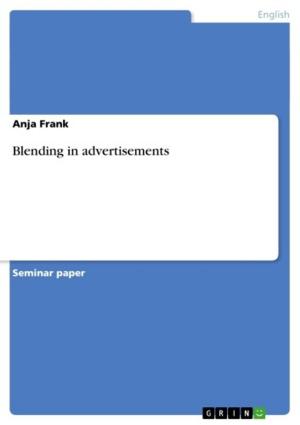Robert Rauschenberg's 'Combines' - Masterpieces of the New Sensibility - Between Abstract Expressionism and Pop Art
Masterpieces of the New Sensibility - Between Abstract Expressionism and Pop Art
Nonfiction, Reference & Language, Study Aids, ESL, Foreign Languages| Author: | Sonja Longolius | ISBN: | 9783638399296 |
| Publisher: | GRIN Publishing | Publication: | July 18, 2005 |
| Imprint: | GRIN Publishing | Language: | English |
| Author: | Sonja Longolius |
| ISBN: | 9783638399296 |
| Publisher: | GRIN Publishing |
| Publication: | July 18, 2005 |
| Imprint: | GRIN Publishing |
| Language: | English |
Seminar paper from the year 2004 in the subject English Language and Literature Studies - Culture and Applied Geography, grade: 1,7, Free University of Berlin (John-F.-Kennedy Institut), 13 entries in the bibliography, language: English, abstract: For a thorough understanding of the development of the American art scene in the 1950s and 1960s, it is essential to have a close look on the early work of the forerunner Robert Rauschenberg whose art bridged the way between Abstract Expressionism and Pop Art. In this context, it is equally important to analyze Susan Sontag's essays on art and style from the mid-1960s which had a precursory function in the art critic world and promoted a new kind of sensibility to the audience. To understand the development of Rauschenberg's art concept, which was breathtakingly new at its time, it is inevitable to look at his artistic career and the different influences on his work from artistic models, teachers, and fellow artists. Additionally, an analysis of the 1950s and 1960s art scene and the change of the audience's reception are equally necessary to recognize the significance of Rauschenberg's work for its time and beyond. Sontag was one of the first critics to fully acknowledge the importance of Rauschenberg's ideas for the development of the American art scene. Her essay collection is thus in itself a pioneer work of a new kind of art criticism. Rauschenberg's artwork as well as Sontag's essays on the arts challenged people's perspective on art and its functions. Even though Sontag only directly refers twice to Rauschenberg's artwork in her essay collection 'Against Interpretations', her ideas of the new kind of art of the late 1950s and early 1960s nevertheless strongly correspond to Rauschenberg's art concept. The artist and the art critic thus paved the way for a new understanding of art and its reception.
Seminar paper from the year 2004 in the subject English Language and Literature Studies - Culture and Applied Geography, grade: 1,7, Free University of Berlin (John-F.-Kennedy Institut), 13 entries in the bibliography, language: English, abstract: For a thorough understanding of the development of the American art scene in the 1950s and 1960s, it is essential to have a close look on the early work of the forerunner Robert Rauschenberg whose art bridged the way between Abstract Expressionism and Pop Art. In this context, it is equally important to analyze Susan Sontag's essays on art and style from the mid-1960s which had a precursory function in the art critic world and promoted a new kind of sensibility to the audience. To understand the development of Rauschenberg's art concept, which was breathtakingly new at its time, it is inevitable to look at his artistic career and the different influences on his work from artistic models, teachers, and fellow artists. Additionally, an analysis of the 1950s and 1960s art scene and the change of the audience's reception are equally necessary to recognize the significance of Rauschenberg's work for its time and beyond. Sontag was one of the first critics to fully acknowledge the importance of Rauschenberg's ideas for the development of the American art scene. Her essay collection is thus in itself a pioneer work of a new kind of art criticism. Rauschenberg's artwork as well as Sontag's essays on the arts challenged people's perspective on art and its functions. Even though Sontag only directly refers twice to Rauschenberg's artwork in her essay collection 'Against Interpretations', her ideas of the new kind of art of the late 1950s and early 1960s nevertheless strongly correspond to Rauschenberg's art concept. The artist and the art critic thus paved the way for a new understanding of art and its reception.















